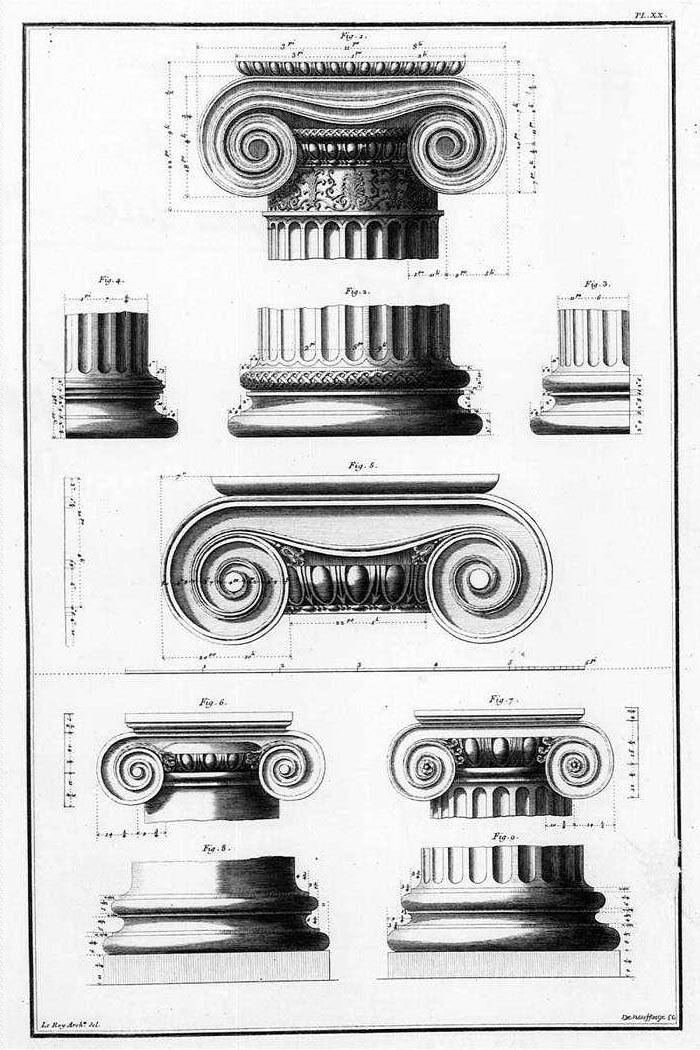
Ionic order
The Ionic order is one of the three canonic orders of classical architecture, the other two being the Doric and the Corinthian. There are two lesser orders: the Tuscan (a plainer Doric), and the rich variant of Corinthian called the composite order. Of the three classical canonic orders, the Corinthian order has the narrowest columns, followed by the Ionic order, with the Doric order having the widest columns.
The Ionic capital is characterized by the use of volutes. The Ionic columns normally stand on a base which separates the shaft of the column from the stylobate or platform while the cap is usually enriched with egg-and-dart.
The ancient architect and architectural historian Vitruvius associates the Ionic with feminine proportions (the Doric representing the masculine).[1]
19th century illustration of multiple polychrome elements of Ancient Greek architecture, including an Ionic capital in the top left, by Jacques Ignace Hittorff
Ancient Greek Ionic columns in the Temple of Apollo at Bassae, Bassae, Greece, illustration by Charles Robert Cockerell, unknown architect, c.429-400 BC[16]
Ancient Greek Ionic columns of the Erechtheion, Athens, Greece, with parallel volutes, unknown architect, 421-405 BC[17]
Roman Ionic corner capital from the Temple of Portunus, Rome, with two sides with volutes, and one for the corner of the facade projecting at a 45° angle, unknown architect, early 4th century BC
Roman Ionic columns of the Temple of Saturn, Rome, with diagonal volutes, unknown architect, 3rd of 4th century AD[18]
Byzantine Ionic capital in the Hagia Sophia, Istanbul, Turkey, by Anthemius of Tralles or Isidore of Miletus, 6th century[19]
Renaissance Ionic columns of the Villa La Rotonda, outside Vicenza, Italy, by Andrea Palladio, 1567-1605
Baroque Ionic columns on the garden façade of the Palace of Versailles, Versailles, France, by Jules Hardouin-Mansart, 1678–1688[21]
Baroque Ionic columns in the Karlskirche, Vienna, Austria, 1715–1737, by Johann Bernhard Fischer von Erlach[22]
Baroque Solomonic Ionic columns of the Monastery of San Francisco, Antigua, Guatemala, unknown architect, early 17th century[23]
Rococo Ionic columns in Vierges modernes, painted by Jean Raoux, 1728, oil on canvas, Palais des Beaux-Arts de Lille, Lille, France
Rococo Ionic pilasters on the facade of the Amalienburg, Nymphenburg Palace Park, Munich, Germany, by François de Cuvilliés, 1734-1739[24]
Rococo pilasters on the facade of the Église Saint-Jacques de Tarascon, Tarascon, France, by Jean-Baptiste Franque and Antoine Damour, 2nd half of the 18th century[25]
Louis XVI style caryatids with Ionic capitals on their heads, on a jewelry locket of Marie-Antoinette, by Ferdinand Schwerdfeger, 1787, mahogany, mother-of-pearl inlays, paintings under glass, porcelain plate, and gilded bronzes, Chambre de la Reine, Palace of Versailles, Versailles, France[27]
Greek Revival Ionic columns of the Branch Bank of the United States, now in the Charles Engelhard Court of the Metropolitan Museum of Art, New York City, inspired by those of the Temple of Artemis Agrotera in Athens, by Martin E. Thompson, 1824
Neoclassical reinterpetation of the Ionic order, with acanthuses just above the base and ram horn-shaped volutes, of the Fontaine Cuvier, Paris, designed by Alphonse Vigoureux and sculpted by Jean-Jacques Feuchère and Pierre-Jules Pomateau, 1840-1846
Greek Revival Ionic columns of the main building of the Academy of Athens, inspired by those of the Erechtheum in Athens, by Theophilus Hansen, 1859-1885
Neoclassical Ionic columns of the Town Hall of the 1st arrondissement of Paris, by Jacques Ignace Hittorff, 1858-1860
Neoclassical Ionic capital with a festoon between its volutes, part of the entrance portico of the Villa Eilenroc, Antibes, France, by Charles Garnier, 1860-1867
Neoclassical Ionic pilasters on the façade of the Gare du Nord, Paris, by Jacques Ignace Hittorff, 1861-1865[28]
Beaux Arts Ionic columns on the facade of the Ducourneau Theater, Agen, France, by Guillaume Tronchet, 1906-1908
Polychrome Greek Revival Ionic capitals in the Washington Union Station, Washington, D.C., US, by Daniel Burnham, c.1907
Beaux Arts Ionic pilasters in the entrance hallway of the Rue de la Paix no. 23, Paris, unknown architect, 1908
Beaux Arts Ionic columns and pilasters of the Cantacuzino Palace, Florești, Romania, by Ion D. Berindey, 1910-1916
Beaux Arts Ionic pilasters on the facade of the Hôtel Roxoroid de Belfort (Avenue Bugeaud no. 29), Paris, 1911, by André Arfvidson
Conspicuous Greek Revival Ionic capital in the New Orleans Museum of Art, New Orleans, US, inspired by those of the Erechtheum in Athens, by Samuel Abraham Marx, 1911
Neoclassical Ionic columns in a Secessionit poster, by Franz Stuck, 1911, lithograph, Poster Collection of the Basel School of Design, Basel, Switzerland
Art Deco and Neoclassical Ionic pilasters in the Severance Hall, Cleveland, US, by Walker and Weeks, 1931
Stalinist Ionic columns of the Colonels' Quarter (Șoseaua Panduri no. 60-62), Bucharest, 1950–1960, by I.Novițchi, C.Ionescu, C.Hacker and A.Șerbescu[30]
Postmodern reinterpretation of the Ionic column as the Capitello seating, designed by Studio 65 and produced by Gufram, differentiated-density polyurethane foam coated with latex rubber, 1972, unknown location[31]
Postmodern vase inspired by the Ionic capital, deisgned by Michael Graves for Swid Powell, 1989, glazed porcelain, Indianapolis Museum of Art, Indianapolis, US[32]
New Classical Greek Revival Ionic columns in the Gonville and Caius College Hall, Cambridge, UK, inspired by those from the Temple of Apollo at Bassaem by John Simpson, 1998
Postmodern reinterpretations of Ionic columns of the Jacksonville Public Library, Jacksonville, US, by Robert A. M. Stern, 2005
Ancient Greek architecture
Aeolic order
Hodge, Susie (2019). The Short Story of Architecture. Laurence King Publishing. 978-1-7862-7370-3.
ISBN
Ionic order exemplified in architecture of Buffalo, New York
Ionic order

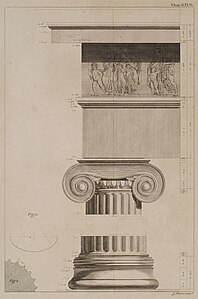
![Ancient Greek Ionic columns in the Temple of Apollo at Bassae, Bassae, Greece, illustration by Charles Robert Cockerell, unknown architect, c.429-400 BC[16]](http://upload.wikimedia.org/wikipedia/commons/thumb/f/f6/Templeofapolloepikouriosbassae.jpg/227px-Templeofapolloepikouriosbassae.jpg)
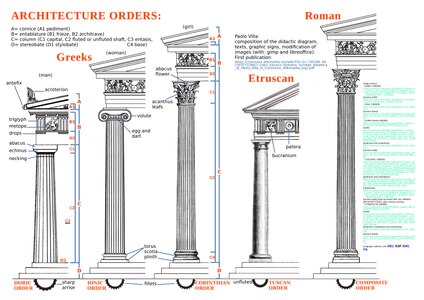
![Ancient Greek Ionic columns of the Erechtheion, Athens, Greece, with parallel volutes, unknown architect, 421-405 BC[17]](http://upload.wikimedia.org/wikipedia/commons/thumb/f/f1/Erechtheion_Temple.jpg/404px-Erechtheion_Temple.jpg)
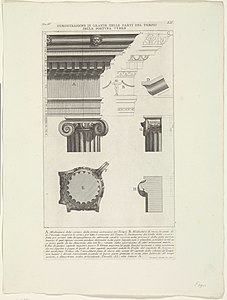
![Roman Ionic columns of the Temple of Saturn, Rome, with diagonal volutes, unknown architect, 3rd of 4th century AD[18]](http://upload.wikimedia.org/wikipedia/commons/thumb/0/06/Roman_Forum_Temple_of_Saturn.jpg/450px-Roman_Forum_Temple_of_Saturn.jpg)
![Byzantine Ionic capital in the Hagia Sophia, Istanbul, Turkey, by Anthemius of Tralles or Isidore of Miletus, 6th century[19]](http://upload.wikimedia.org/wikipedia/commons/thumb/9/97/Hagia_Sophia_%2815468276434%29.jpg/400px-Hagia_Sophia_%2815468276434%29.jpg)

![Baroque Ionic columns in the Santi Luca e Martina, Rome, by Pietro da Cortona, 1634-1669[20]](http://upload.wikimedia.org/wikipedia/commons/thumb/a/af/Interior_Luca_e_Martina_33.JPG/200px-Interior_Luca_e_Martina_33.JPG)
![Baroque Ionic columns on the garden façade of the Palace of Versailles, Versailles, France, by Jules Hardouin-Mansart, 1678–1688[21]](http://upload.wikimedia.org/wikipedia/commons/thumb/9/9b/2017_Escultura._Palacio_de_Versalles_P41.jpg/200px-2017_Escultura._Palacio_de_Versalles_P41.jpg)
![Baroque Ionic columns in the Karlskirche, Vienna, Austria, 1715–1737, by Johann Bernhard Fischer von Erlach[22]](http://upload.wikimedia.org/wikipedia/commons/thumb/3/3e/Iglesia_de_San_Carlos_Borromeo%2C_Viena%2C_Austria%2C_2020-01-31%2C_DD_52-54_HDR.jpg/363px-Iglesia_de_San_Carlos_Borromeo%2C_Viena%2C_Austria%2C_2020-01-31%2C_DD_52-54_HDR.jpg)
![Baroque Solomonic Ionic columns of the Monastery of San Francisco, Antigua, Guatemala, unknown architect, early 17th century[23]](http://upload.wikimedia.org/wikipedia/commons/thumb/9/93/2010.05.13.173929_Iglesia_San_Francisco_Antigua_Guatemala.jpg/450px-2010.05.13.173929_Iglesia_San_Francisco_Antigua_Guatemala.jpg)

![Rococo Ionic pilasters on the facade of the Amalienburg, Nymphenburg Palace Park, Munich, Germany, by François de Cuvilliés, 1734-1739[24]](http://upload.wikimedia.org/wikipedia/commons/thumb/d/d7/20230209_Amalienburg_Nymphenburg.jpg/450px-20230209_Amalienburg_Nymphenburg.jpg)
![Rococo pilasters on the facade of the Église Saint-Jacques de Tarascon, Tarascon, France, by Jean-Baptiste Franque and Antoine Damour, 2nd half of the 18th century[25]](http://upload.wikimedia.org/wikipedia/commons/thumb/1/1e/%C3%89glise_Saint-Jacques_de_Tarascon_45.jpg/400px-%C3%89glise_Saint-Jacques_de_Tarascon_45.jpg)
![Neoclassical Ionic columns at Syon House, London, by Robert Adam, c.1761-1765[26]](http://upload.wikimedia.org/wikipedia/commons/thumb/1/1a/Syon_House_%2833315382913%29.jpg/200px-Syon_House_%2833315382913%29.jpg)
![Louis XVI style caryatids with Ionic capitals on their heads, on a jewelry locket of Marie-Antoinette, by Ferdinand Schwerdfeger, 1787, mahogany, mother-of-pearl inlays, paintings under glass, porcelain plate, and gilded bronzes, Chambre de la Reine, Palace of Versailles, Versailles, France[27]](http://upload.wikimedia.org/wikipedia/commons/thumb/0/01/P1030075_%285015797888%29.jpg/400px-P1030075_%285015797888%29.jpg)



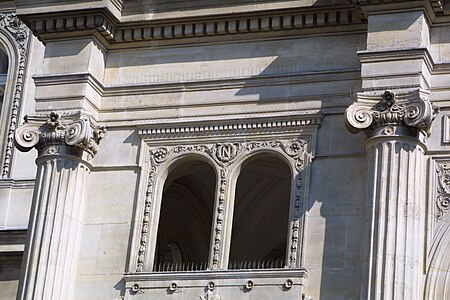

![Neoclassical Ionic pilasters on the façade of the Gare du Nord, Paris, by Jacques Ignace Hittorff, 1861-1865[28]](http://upload.wikimedia.org/wikipedia/commons/thumb/0/02/Facade_of_Gare_de_Paris-Nord%2C_Paris_10_April_2017.jpg/450px-Facade_of_Gare_de_Paris-Nord%2C_Paris_10_April_2017.jpg)
![Beaux Arts Ionic columns of the Petit Palais, Paris, by Charles Giraud, 1900[29]](http://upload.wikimedia.org/wikipedia/commons/thumb/1/14/Petit_Palais%2C_Paris_8th_004.JPG/195px-Petit_Palais%2C_Paris_8th_004.JPG)









![Stalinist Ionic columns of the Colonels' Quarter (Șoseaua Panduri no. 60-62), Bucharest, 1950–1960, by I.Novițchi, C.Ionescu, C.Hacker and A.Șerbescu[30]](http://upload.wikimedia.org/wikipedia/en/thumb/0/07/60-62_%C8%98oseaua_Panduri%2C_Bucharest_%2811%29.jpg/349px-60-62_%C8%98oseaua_Panduri%2C_Bucharest_%2811%29.jpg)
![Postmodern reinterpretation of the Ionic column as the Capitello seating, designed by Studio 65 and produced by Gufram, differentiated-density polyurethane foam coated with latex rubber, 1972, unknown location[31]](http://upload.wikimedia.org/wikipedia/commons/thumb/e/ec/Capitello%2C_Studio65.jpg/400px-Capitello%2C_Studio65.jpg)
![Postmodern vase inspired by the Ionic capital, deisgned by Michael Graves for Swid Powell, 1989, glazed porcelain, Indianapolis Museum of Art, Indianapolis, US[32]](http://upload.wikimedia.org/wikipedia/commons/thumb/a/a6/Michael_graves_per_swid_powell_design%2C_vaso%2C_1989.jpg/335px-Michael_graves_per_swid_powell_design%2C_vaso%2C_1989.jpg)
![Postmodern Ionic column of the M2 Building, Tokyo, Japan, by Kengo Kuma, 1991[33]](http://upload.wikimedia.org/wikipedia/commons/thumb/c/ca/M2%E3%83%93%E3%83%AB_%28%E4%B8%96%E7%94%B0%E8%B0%B7%E5%8C%BA%29.jpeg/400px-M2%E3%83%93%E3%83%AB_%28%E4%B8%96%E7%94%B0%E8%B0%B7%E5%8C%BA%29.jpeg)

